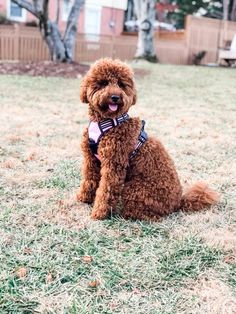Goldendoodles hypoallergenic, a cross between Golden Retrievers and Poodles, are renowned for their charming personalities, trainability, and low-shedding coats. While no dog is truly hypoallergenic, Goldendoodles inherit the Poodle’s hypoallergenic traits, making them a popular choice for allergy sufferers.

While no dog breed is truly hypoallergenic, Goldendoodles are often considered a good choice for people with allergies. This is because they inherit the Poodle’s low-shedding coat, which means they produce less dander, the main trigger for dog allergies.
What is dander?
Dander is made up of tiny flakes of dead skin cells that animals shed. When these flakes come into contact with saliva, they can become airborne and cause allergic reactions in people who are sensitive to them.
How do Goldendoodles reduce dander?
Poodles have a single coat of hair that is typically curly or wavy. This type of coat does not shed as much as a double coat, which is the type of coat that Golden Retrievers have. Goldendoodles that inherit the Poodle’s coat type will therefore produce less dander.
Are all Goldendoodles hypoallergenic?
Not all Goldendoodles are hypoallergenic. The amount of dander that a Goldendoodle produces will depend on its coat type and its genetics. Goldendoodles with curly or wavy coats are typically more hypoallergenic than those with straight coats.
Goldendoodles from multigenerational breeding programs, which means they have been bred with Poodles for several generations, are also more likely to be hypoallergenic.
What else can I do to reduce my allergies to Goldendoodles?
In addition to choosing a Goldendoodle with a low-shedding coat, there are a few other things you can do to reduce your allergies:
- Bathe your Goldendoodle regularly. This will help to remove dander from their coat.
- Brush your Goldendoodle’s coat regularly. This will help to remove loose hair and prevent matting, which can trap dander.
- Keep your Goldendoodle out of your bedroom. This will help to reduce the amount of dander in your bedroom.
- Use an air purifier in your home. This will help to remove dander and other allergens from the air.
What to Look for in a Hypoallergenic Goldendoodle
If you are considering getting a Goldendoodle, there are a few things you can look for to increase your chances of finding a hypoallergenic dog:
- Choose a curly-coated Goldendoodle.
- Choose an F1B or F2B Goldendoodle.
- Choose a Goldendoodle from a reputable breeder who health tests their dogs and selectively breeds for low-shedding traits.
Tips for Managing Allergies with a Goldendoodle
Even with a hypoallergenic dog, allergies can persist. Here are a few tips for managing allergies with a Goldendoodle:
- Brush your dog regularly to remove dander.
- Bathe your dog regularly, especially during allergy season.
- Use an air purifier to remove dander from the air.
- Keep your dog out of your bedroom.
- Wash your bedding regularly.
Testing for Allergies
If you are unsure if you are allergic to dogs, you can get an allergy test. This will help you identify specific allergens and determine your sensitivity level.
Spending Time with a Goldendoodle
Before committing to a Goldendoodle, it is a good idea to spend some time with one to assess your allergic reaction. Observe if you experience symptoms like sneezing, runny nose, or itchy eyes.
Remember, every dog is an individual, and even hypoallergenic breeds may trigger allergies in some people. It is essential to meet the dog, spend time with it, and consult your doctor to make an informed decision.
Goldendoodles and their hypoallergenic qualities
Understanding Hypoallergenic Dogs:
Hypoallergenic dogs produce less dander, the primary trigger for dog allergies. Their shedding patterns and allergens vary, making some breeds more suitable for allergy sufferers.
Goldendoodle Coat Types:
Goldendoodles come in three coat types:
Straight:
Similar to Golden Retrievers, straight coats require less grooming but may shed more.
Wavy:
A combination of straight and curly, wavy coats offer moderate shedding and grooming needs.
Curly:
Inheriting the Poodle’s coat, curly coats shed minimally and require regular grooming to prevent matting.
F1B, F2B, and Multigenerational Goldendoodles:
Goldendoodles are categorized based on their breeding generations:
F1B:
A cross between an F1 Goldendoodle (Golden Retriever and Poodle) and a Poodle, F1B Goldendoodles have a higher probability of inheriting the Poodle’s hypoallergenic traits.
F2B: A cross between two F1B Goldendoodles, F2B Goldendoodles typically have a low-shedding, curly coat.
Multigenerational:
Goldendoodles bred further from the original cross may vary in their hypoallergenic qualities.
Choosing a Hypoallergenic Goldendoodle:
To increase your chances of finding a hypoallergenic Goldendoodle:
Choose a reputable breeder:
Responsible breeders prioritize health testing and selectively breed for low-shedding traits.
Select a curly-coated Goldendoodle:
Curly coats are less likely to shed and trap dander.
Consider an F1B or F2B Goldendoodle:
These generations have a higher probability of inheriting hypoallergenic traits.
Managing Allergies with a Goldendoodle:
Even with a hypoallergenic dog, allergies can persist. Regular grooming, bathing, and air filtration can help reduce dander levels. Regular vacuuming, washing bedding, and keeping the dog out of bedrooms can further minimize exposure.
Testing for Allergies:
If you’re unsure if you have dog allergies, consider allergy testing to identify specific allergens and determine your sensitivity level.
Spending Time with a Goldendoodle:
Before committing to a Goldendoodle, spend time with one to assess your allergic reaction. Observe if you experience symptoms like sneezing, runny nose, or itchy eyes.
More Info:-https://animalsuk.com/